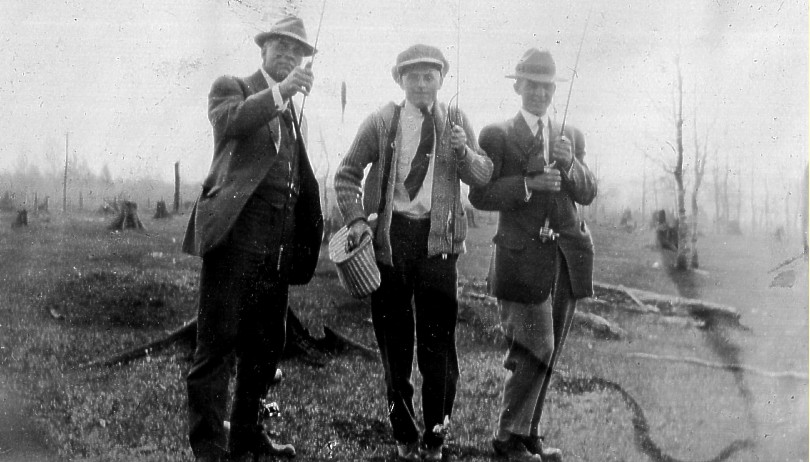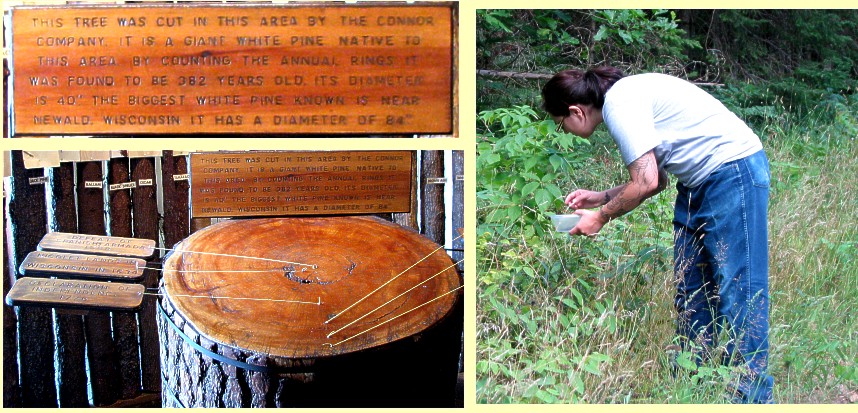
Kansas Snapshots by Gloria Freeland - Sept. 2, 2011
Timber!
As a prairie-raised gal, I like to see the sunrise and sunset with a clear view to the horizon. But that's not to say I don't like the forest. In fact, when we go to our cottage in Wisconsin's North Woods, one of my favorite things is the way the trees seem to wrap themselves around us. The effect of sunlight filtered through the pines, tamaracks and birches is mesmerizing, and the scent of the pine needles is almost intoxicating.
I had imagined the forest as always being there, but husband Art recently showed me an early 1900s photo that told a different story. It was of three men trout fishing. At first, the picture made me smile as the men were all dressed in coats and ties as if they were about to go to a formal party, and the fish appeared to be little bigger than minnows.
But then my eye drifted to the backdrop. Only a few scraggly trees could be made out among a sea of stumps.
When the first white settlers arrived in Wisconsin in the early 19th century, it was heavily timbered. Some saw an opportunity to get rich. They bought land, cut virtually every tree for the lumber and then sold the stump-filled acreage to immigrants. Then they moved on to the next section of virgin forest.
The cutting moved from the southern border toward the north. While it lasted, the white-pine boards built the homes and many of the businesses in southern Wisconsin cities such as Milwaukee and the growing cities to the south such as Chicago, St. Louis and even New Orleans.
By the mid-19th century, the lumbermen were about halfway through the state. It was around that time that the great wave of settlers from Germany began to arrive in America. Germans preferred land that was already cleared of trees. Today, Wisconsin has more people of German descent than any other state, and the cheap land cleared by its lumber industry was an important factor in attracting their forefathers.
That cleared land once made Wisconsin the leading wheat producing state. But the soil and short growing season would eventually cause farmers to turn to dairying as their main agricultural endeavor.
But in the north, lumbering remained an important industry well into the 20th century. Much of the logging was done in the winter when the lack of foliage and iced trails made moving the heavy logs easier. The manpower supply was also better in the cold months for many of the state's farmers had less to do once the growing season was over. Art's great-grandfather Philo Sheldon was one of those who boarded trains for the pine woods as did his eldest son Lorenzo. It was dangerous work, and both died in logging accidents.
Art's grandfather Edgar Vaughan worked in several lumber camps as a scaler - a job that involved measuring a tree and estimating the amount of cut lumber it would produce.
Lumbering even played an important role in Art being here. In the late 1920s, Donna, who would become his mother, and two friends spent much of their spare time that spring making new clothes for a much-anticipated summer trip into Northern Wisconsin. Frieda, a friend of Donna's, had told her about a picturesque lake she had seen the summer before. It was surrounded by trees and had a small cabin that could be rented.
But the lumbermen had been hard at work that winter. When Donna and her friends arrived, the lake was there, but every last tree was gone. The disappointed young women decided to turn back and look for another place closer to their homes. They found a cottage to rent and then went into town for groceries. Tom Vaughan was working in the same town, and he and a friend saw the girls pull in. The friend suggested they get to know those new gals in town and, as they say, the rest is history.
The story of the immigrants who settled the northern half of the state's cleared lands didn't have the happy ending Donna and Tom had. The sandy soils were ill-suited for farming and after a few good years, the soil nutrients were depleted. Yields began to decline and mortgages couldn't be paid. Little by little, the land reverted to what it was well suited for - growing trees.
Today, some of the trees are harvested for commercial purposes. One of the companies Art's grandfather worked for is now a leading supplier of hardwood flooring used in gymnasiums.
But in increasing numbers, tourists and sportsmen came as the forests regrew. The Chequamegon and Nicolet forests near our place were established in the early 1930s. Combined in February 1998, this national forest now covers more than a million and a half acres. Biologists with Wisconsin's Department of Natural Resources say that in some areas, this once clear-cut land has returned to how it was when the White Man first arrived.
Today, only a few of the area's older residents retain faint memories of the lumber camps. Still, references to those times are everywhere. Many Northern Wisconsin towns having logging museums. Rhinelander's grand Victorian homes remain, originally built for the North Woods lumber barons. Some restaurants advertise Paul-Bunyan size meals. Hayward, Wisconsin has an annual Lumberjack World Championship contest where participants from all over the world compete in log rolling, ax throwing, tree climbing and many other skills that once were crucial to lumberjacks.
As for our family, two days before we came home, we visited the Connor company's Camp 5 logging museum in Laona, Wisconsin. The museum had old photos of logging camps, tools, antique household appliances, dugout canoes, money issued by logging companies and cooking equipment.
Most interesting to me was a 40-inch diameter section of trunk from a 382 year old white pine. Several rings were labeled with an important historical event that occurred the year it grew: the defeat of the Spanish Armada in 1588; the Declaration of Independence in 1776; one of the first locomotives in 1804; Abraham Lincoln's Gettysburg Address in 1863.
The following day, to get up-close and personal with the forest, three of us put on old clothes and picked wild blackberries.
So, while in my heart I am and always will be a Kansas prairie gal, I've also come to love the tree-covered lands of Wisconsin.

Three fisherman in the not-so-picturesque landscape of post-lumbered Wisconsin.

Lower left: trunk section of 382-year-old white pine tree; upper left: sign above
trunk; right: daughter-in-law Lacey picking blackberries in the national forest.